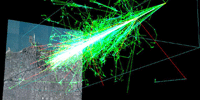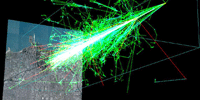Anatomy of the Cosmic Ray Energy Spectrum
High-energy cosmic rays reaching the Earth are only measured indirectly—through the cascade of particles, called air showers, that result from the collision of cosmic rays with atoms in the atmosphere. The spectrum of cosmic rays thus obtained contains a kink, or “knee,” where the spectrum, which falls steeply with energy, changes slope and begins to fall even more sharply. Past experiments have indicated that the knee results from a decrease in the flux of light nuclei. Astrophysical models indicate that this is the end of light-nuclei cosmic rays originating in our own Milky Way. The same models expect that heavier nuclei in the cosmic rays from our Galaxy will have a similar drop at a higher energy. Above this energy, the remaining cosmic rays should be of extragalactic origin.
Now, the air-shower experiment KASCADE-Grande is reporting in Physical Review Letters the observation of a second “knee.” The analysis separates “electron rich” showers (which should be the result of incoming light-nuclei cosmic rays) from “electron poor” showers (from heavy-nuclei cosmic rays), and finds that the second knee is enhanced in the spectrum from electron-poor events. This finding supports the interpretation that the second knee results from a decrease of the flux of heavy nuclei. Moreover, this structure occurs in the energy range expected for such heavy nuclei by astrophysical models. The result strongly supports these models of the origin of Galactic cosmic rays and gives important input for the study of extragalactic ultrahigh-energy cosmic rays. – Stanley Brown





